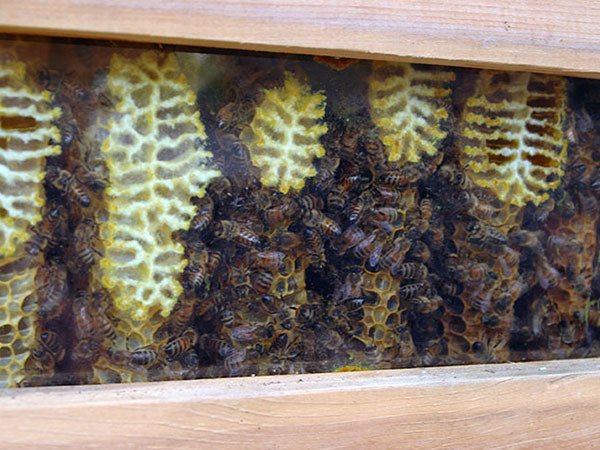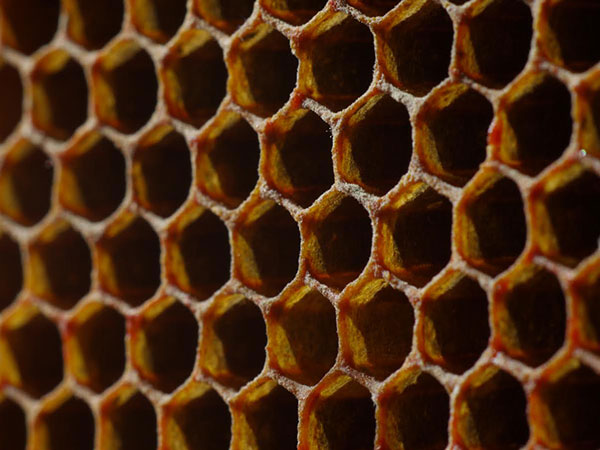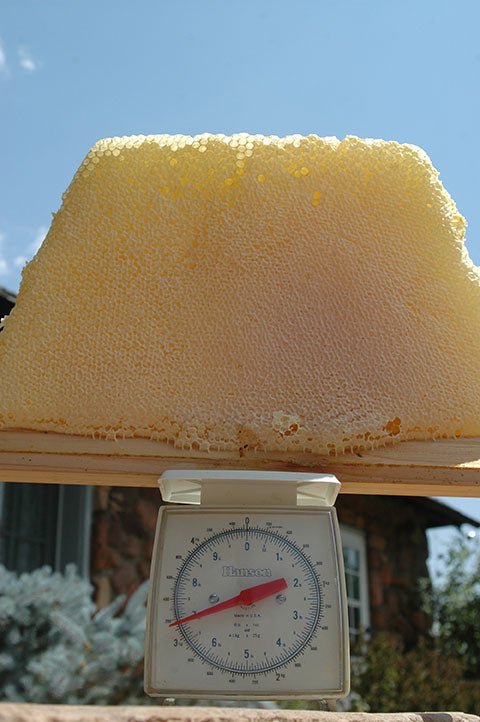It's fall and there are only a few bees when I look through the window. There could be several reasons why in the Fall you might be seeing fewer bees through the window of your top bar hive.
One possibility, is the number of bees in the colony naturally decreases in the fall. Usually there is little nectar available in the fall months, so there is no need for a huge amount of worker bees.

Fall leaves floating in creek
Leaves are falling from the trees and there is no nectar available for the bees.
The queen naturally slows down egg laying and normally stops laying around late October in regions with a climate similar to zones 4-6. In the winter, the colony needs to contract in numbers, but be substantial enough to overwinter successfully. This is a very tricky balance. If the queens' genetics are not adapted to cold weather areas, she might continue laying past the October mark and have too big a colony for overwintering. Too big means, too many bees for the honey stores available which can lead to too many hungry bees in the hive.

Spring Time: Looking through the window of the hive in the spring time,
you normally see many bees.

Fall Time: Looking through the window of the hive in the fall time you may
see fewer bees.
With the changing global weather patterns, even well adapted bees may have trouble as temperatures become more and more extreme or “unseasonable”. If the fall temperatures are unseasonably warm, the bees do not go into hibernation, but stay active and continue to consume their honey stores. Last year was just one example of these unusual weather events.

Ominous weather clouds
The 2013–14 North American cold wave was an
extreme weather event extending from December 2013 to April 2014,
and was also part of an unusually cold winter affecting parts of Canada and the Eastern United States
Read more....
Typically, well adapted wild colonies head into winter with a much smaller nest cluster compared to bred bees. Italians, and many other bred bees that come in packages tend to keep larger clusters going into winter. If the bees genetics have been acclimated to the warmer climates of California, for example, the bees are not expecting the shorter warm season. This is why catching wild or feral bees, has an advantage, because the bees are more likely to have survivor behaviors that have been selected from your specific area. Even if you started with packaged bees, if they do manage to make it through the winter, you have the opportunity in the spring for a new queen to emerge from your hive to open mate with drones from the local survivor genetics. And now your colony will have local genetic behaviors giving them a great advantage over bred bees when unusual weather events happen.

Bees swarming in the air
Bees swarming in the air, quite a sight. These bees made it through the winter and quickly increased their numbers in the spring and
were able to swarm!
Another reason for a lack of observable bees through the window may be that the cluster of bees is condensed in-between the combs at the center of the hive. On a chilly day the bees will be clustered towards the top of the hive and you can't see them looking through the window. The bees also will crawl into the empty comb cells to keep warm, so there will actually be a large number of bees clustered in the cells, adding to the illusion that the bees have vanished.

Combs in the hive with no bees
If your window is on the north side of the hive, it is quite possible that the bees are on the warmer south side of the hive, away from the window.
If you still want proof that the bees are in there, tap on the side of the hive and listen, with your ear pressed against the hive. Too much tapping and you better have your bee suit on!
In our BackYardHive DVD, Chapter 8: How the Colony is Organized, the video shows the expansion of the brood nest and how this increase in bees correlates to the increase of available nectar and pollen in the spring and summer months. More blooms = more bees in the hive. The goal of the colony is to increase their numbers to take full advantage of the nectar flows in the spring and summer, but to then contract to a sustainable size colony for winter hibernation.

Bees head first inside the comb cells
This is what bees look like tucked into empty comb cells.
Some folks have heard that they need to feed, feed, feed during the fall, so the bees have plenty of stores for winter. In actuality the bees also need some empty comb cells to crawl into during the winter months to create a cluster and to keep warm. Feeding will cause the bees to store up the feed in their little winter beds, so they will have no place to rest their sleepy heads.

Honeycomb cells that are empty
As the temperatures drop the bees contract into a tighter ball and crawl into the empty comb cells to tightly cluster together. So there is a balance, if you feel you have to feed, don't over feed, empty cells are a benefit to the overwintering cluster.
Determining How Much Honey is in Your Hive
A good way to check the amount of honey in the hive is to remove the roof, not the inner lid, and lift the back of the hive to get an idea of the weight, 10 pounds?, 20 pounds? Then lift up the front of the hive, and try to estimate the weight you are feeling. I use a 4 finger technique. Try to lift with one finger, then try two. If I can barely lift with three fingers, this is borderline, but good. Often you can't even lift the ends of the hive with one arm. You may be surprised how heavy the hive feels.

Remove the roof of the hive to feel the weight (Here we are storing beekeeping supplies under the roof of our hive)
If you have more than one hive you can compare the weight of each hive. If you want to get more accurate use a meat scale, hook it under the front or back handles of your hive. The Golden Mean hive, empty of bees and combs, and lifting the weight of the front or back of the hive on the meat scale is 15 pounds, so you can subtract this from your total.

Weighing the front of the Golden Mean Hive, (empty) is 15 pounds.

A full Golden Mean honeycomb weighs about 7 pounds!
Now record the results comparing weight and survival of a hive. This will give you insurance and peace of mind, when the nor easterly blow.
I rarely feed the bees in the fall and especially not sugar water. Any liquid in the hive must be evaporated and all this excess moisture is difficult for the bees to fan out of the hive, especially when they are sluggish because of the cold. The absolute best way to feed a colony that may not make it through the winter is to use full combs of honey from your hive or from a friend that is treatment free. We always have full topbar honey combs that we set aside from spring harvest, just in case a hive is struggling in the fall. Here is a great way to store the combs and keep them safe from wax moths. A cooler that is a correct width and two strips of wood mounted to the sides to hang the bars on, makes for a great emergency comb storage solution.

Honeycombs stored in a cooler for future use
Often a single comb can make a difference for bees that have a small amount of honey stored and are boarder line going into winter.
This year we created a special honey comb holder that can serve this exact purpose. And it can also display your beautifully harvested honeycombs
in your house. See more about the Glass Honey Comb Display & Serving Tray

Related Articles
Winter Feeding in a Top Bar Hive
Corwin talks about the cluster or ball of bees as a "dynamic system".
SaveSave 




























